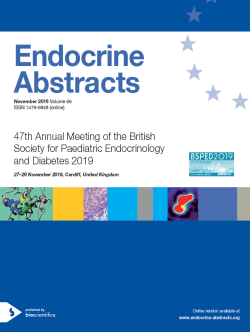
47th Meeting of the British Society for Paediatric Endocrinology and Diabetes
Cardiff,
UK
27 Nov 2019 - 29 Nov 2019

ORAL COMMUNICATIONS
Oral Communications 7
ea0066oc7.1 | Oral Communications 7 | BSPED2019
Increased and younger alcohol-related hospital admissions in young people with childhood-onset type-1 diabetes: a record-linked longitudinal population study in Wales
Gartner Andrea , Daniel Rhian , Farewell Daniel , Paranjothy Shantini , Townson Julia , Gregory John
ea0066oc7.2 | Oral Communications 7 | BSPED2019
Impact of continuous glucose monitoring on sleep quality in children with type 1 diabetes and their parents: a pilot study
Parmar Meera , Davis Nikki , Hill Catherine
ea0066oc7.3 | Oral Communications 7 | BSPED2019
Improving HbA1c outcomes in young people of transition age with type 1 diabetes using quality improvement methodology
Dymond Emma , Cropper Julie , Trentham Sarah , Kelleher Aoife , Boal Rachel , Bishop Faye , Campbell Fiona
ea0066oc7.4 | Oral Communications 7 | BSPED2019
Monitoring lipid profiles in children and young people with type 1 diabetes mellitus: what should we do with these results?
Park Julie , Bowker Tabitha , Ghatak Atrayee , Mehta Fulya , Deakin Mark , Paul Princy
ea0066oc7.5 | Oral Communications 7 | BSPED2019
Medication adherence during adjunct therapy with statins and ACE inhibitors in adolescents with type 1 diabetes
ea0066oc7.6 | Oral Communications 7 | BSPED2019
Improving referral pathways from primary to secondary care in newly diagnosed type 1 diabetes
Shetty Ambika , Bucknall Catrin , Dyban Maria , Warner Justin , Mathias Jon
ea0066oc7.7 | Oral Communications 7 | BSPED2019
Paediatric Type 2 diabetes in a single centre in East London in the period 2009–2018
Giuffrida Anna , Gevers Evelien
ea0066oc7.8 | Oral Communications 7 | BSPED2019
Children with type 1 diabetes on intensive insulin, in deprived areas and younger onset are at risk of being overweight
Urquhart Alexandra , Warner Justin T
ea0066oc7.9 | Oral Communications 7 | BSPED2019
Does having a first degree relative with type1 diabetes impact on a child and family’s engagement and glycaemic control?
Kiu Evelyne , Darby Alison , Denial Mark , Elder Charlotte



